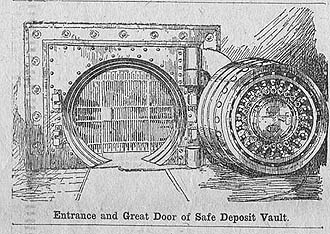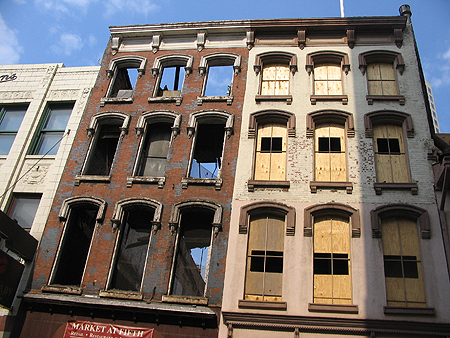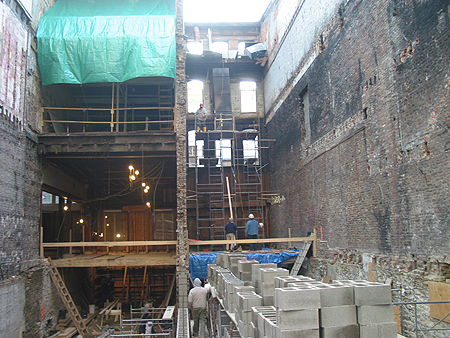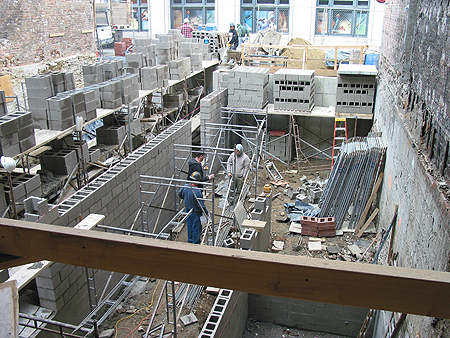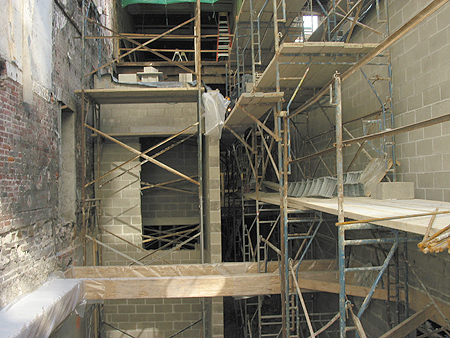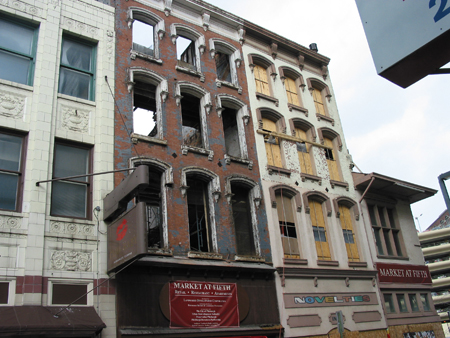
Category Archive: Historic Properties
-
Getty II – Campus Heritage Grants, 2007
Eugene Matta
PHLF News
March 7, 2008Under the auspices of the J. Paul Getty Foundation’s Campus Heritage Grants 2007 program, conservation work continues at California University of Pennsylvania, Indiana University of Pennsylvania, Seton Hill University and Washington & Jefferson College.
PHLF’s team of experts includes a historic architect, horticulturist and landscape designer, architectural historian, and an expert in the construction and rehabilitation of historic buildings.
The work is further supported by PHLF’s administrative staff including its Information Officer and Project Manager.
The collection of four colleges, which includes two private colleges and two public universities, is a significant cross section of the cultural and architectural history of Western Pennsylvania’s academic heritage.
Preservation plans for these institutions are being completed with significant participation by the academic and local communities and will broaden the understanding of the importance of these regional resources and spread the preservation and conservation message throughout the region.
-
Survey of Greene and Washington Counties
Eugene Matta
PHLF News
March 7, 2008The Farm Survey of Greene and Washington Counties, managed by PHLF under the auspices of the Pennsylvania Bureau of Historic Preservation (“BHP”), is about ninety percent complete.
The survey contains a list of 1,150 farms and farmsteads from both counties and includes photographs and descriptions of historic buildings, uses of farm lands, and potential priorities for easements.
The survey focuses primarily on existing historic structures. For the next steps, Landmarks hopes to work with local organizations from both counties to help promote agricultural tourism.
The survey information will also be compiled in a statewide database managed by the BHP.
-
Door to History: New owners of old Union Trust Building hope to find use for bank vault
Wednesday, March 12, 2008
By Sally Kalson, Pittsburgh Post-GazetteWhen the Union Trust Building opened Downtown in 1923, its safe deposit vault in the basement was reported to be the largest and strongest in the world — 80 feet long, 45 feet wide, 8 2/3 feet high, with walls 20 inches thick.
Now, 85 years and several bank mergers and sales later, the vault is still an impressive, if musty, catacomb that harkens back to another era. With its rows of burnished bronze cubbies, clanking gates and massive circular 55-ton door, it could easily be imagined as the set of an old bank heist movie starring James Cagney or Edward G. Robinson.
There’s almost nothing left there to steal now. Citizens Bank, which took over the vault from Mellon Bank after buying the latter’s consumer and small business operation in 2001, began notifying depositors several months ago to empty their lock boxes because it was vacating the premises.
Only about 1,800 of 12,000 boxes were in use at that point. Most have been cleared out by their owners, although some unclaimed boxes remain. On March 21, the vault will officially close; any leftovers will be drilled and moved to the Citizens branch across the street for safekeeping while the bank looks for their owners.
Citizens Bank president Ralph Papa, who was with Mellon for many years before the sale, said there was no need to keep the Union Trust vault in operation.
“We have more than 90 branches around the area, and the vast majority have safe deposit boxes,” he said. “There are lots of places for people to move the contents.”
Still, the closing of the storied vault sounds like the end of an era. But the Union Trust Building’s new owners say they are well aware of the basement’s historic nature.
“We’re looking at a number of uses,” said Rick Barreca, CEO of the Mika Realty Group of Los Angeles, which last month paid $24.1 million for the 11-story property.
“Our hope is that we can work with another financial institution in the future that might make use of the vault,” Mr. Barreca said. “It’s really a work of art, a unique facility that I think is irreplaceable. We have a large commitment to the building, and the vault is one of the benefits of owning it.” …..
That’s a sensible attitude, because it’s hard to see how the structure could be removed without tremendous cost and disruption. Mika is considering excavating under the building for a parking garage, but Mr. Barreca said “there’s plenty of room for that without touching the vault.”
Sparse history
Much has been written about the Union Trust Building from the ground up. The edifice is considered by many to be Downtown’s most spectacular, with its ornate Flemish Gothic exterior, 10-story rotunda, circular skylight and the twin “chapels” on the roof that actually house elevator machinery. It takes up the entire city block bounded by Fifth and Oliver avenues, Grant Street and William Penn Place. The design is credited to F.J. Osterling, but was probably conceptualized by Pierre A. Liesch, who worked for Osterling briefly, according to the late historian James D. Van Trump. In 1973, the building was recognized as a historic landmark.
But when it comes to the underground portion, there’s very little on the historical record. However, one article from the Pittsburgh Sun newspaper, dated Nov. 21, 1932, contained a descriptive bonanza.
“Great Vault Is World’s Largest” was the Sun headline that introduced the facility to the public. The report included illustrations of the vault opening and its interior and noted that the total weight of the doors and equipment was 5 million pounds.
The report described the vaults as “great fire, burglar, flood and mob proof strongholds,” built of “a double tier of interlocked heavy steel beams, surrounded by and imbedded in solid concrete, lined with the hardest and toughest armor plate.
“Every inch is guarded by electric alarms, and every protective device developed by human genius and skill has been installed to make absolutely safe the possessions deposited in it.
“The material is finished in solid bronze, and the boxes are 26 inches deep and are made of open hearth steel, the doors being one-half inch thick. The portable boxes are aluminum and were made by the Aluminum Company of America.”
The article went on to recommend the “impregnable trunk vault” as the ideal repository for silverware, heirlooms, valuable books and other bulky possessions.
All the more noteworthy is the fact that the vaults were retrofitted, because the building was not designed as a bank. It opened in 1917 as the Union Arcade, built by Henry Clay Frick on land he purchased from the Catholic Diocese of Pittsburgh. At the time, it claimed to be the largest arcade in the world, with 240 shops on the first four floors and 760 office suites on the upper levels.
Six years later, the Union Trust Co. took over more than two acres of floor space, put its name on the edifice and its vault under it. The retrofitting was done by Graham, Anderson, Probst & White, successor of D. H. Burnham & Co., architects of the Frick and Oliver buildings.
The newspaper described the vaults as occupying two levels — nearly 28,000 square feet on the safe deposit floor, and some 20,000 square feet on “the silver vault floor” for paintings, bullion and other heavy possessions.
That left the folks at Citizens scratching their heads, because the vault as it exists today has only one floor. “Nobody seems to know about that second floor,” said spokeswoman Angela Wagner.
The vault is changed in other ways as well. The open central area depicted in the Sun’s 1923 illustration is now crammed full of deposit boxes that were forklifted over from Mellon Bank’s Smithfield Street location after that building was sold in 1999 and made into a Lord & Taylor department store that closed five years later.
It’s hard to say for sure if the vault anteroom floor is original. The surface comes up higher than the bottom of the vault door, so the floor must be dropped by means of a long pole and lever to clear the way for swinging the enormous door open or closed. That may be depicted by the curved line in the illustration, but it’s difficult to tell.
The Union Trust Co. merged with Mellon Bank in 1946 to form Mellon National Bank & Trust Co. The building was rechristened Two Mellon Bank Center in the 1990s, but most Pittsburghers never stopped calling it the Union Trust Building.
Mellon — now Bank of New York Mellon — left the premises in 2006, and the structure is virtually empty except for Larrimor’s on the street-level corner of Grant and Fifth. Mika Realty hopes the high-end men’s clothier will remain, and CB Richard Ellis is charged with attracting new retail and office tenants.
As for the vault, it’s not going anywhere.
Sally Kalson can be reached at skalson@post-gazette.com or 412-263-1610.
First published on March 12, 2008 at 12:00 am
-
Owners’ fear: Razing houses will bring down theirs too
Monday, March 10, 2008
By Diana Nelson Jones,
Pittsburgh Post-GazetteThe estate of her dead neighbor owns the condemned vacant row house beside Cynthia Powell’s home on Chateau Street. Its facade is strenuously bowing and trying to persuade hers to come with it.
No contractor has been willing to touch the offending building, and Ms. Powell says she can’t afford the loan she needs to stabilize her house against it. So her house has been condemned, too.
This has been a three-year spiral for Ms. Powell, whose Manchester neighborhood has many pending dates with the wrecking ball. Of the 25 demolitions the city has asked the Historic Review Commission to approve since October 2006, 21 have been in that neighborhood. It’s the only entire neighborhood to have city historic designation, but that status is in danger; less and less density would eventually alter the boundary.
“Once you lose too many, then you have to question: What’s the value of an historic district?” said Tom Hardy, executive director of the Manchester Citizens Corp. The nonprofit development group counted 103 vacant properties — about 20 percent of the neighborhood — in a 2005 inventory and recommended 100 be renovated, he said. Some have been razed, either for safety reasons or because the properties were not feasible fixes, and more are slated for demolition.
“The challenge is,” said Mr. Hardy, “which ones will you be successful at turning around considering realistic market forces?”
Manchester’s story today is a tale of two neighborhoods: the one that tour buses drive through slowly so people can admire the Victorian architecture, and the other of dumb, hollow hulks, their balconies and porches sagging, the definition of their brickwork vague, as if they are literally fading away.
The dual identity coexists side by side in places, and that’s an untenable situation for Ms. Powell, whose house is a party-wall domino trying to remain standing. For Duane Hill, the decrepitude adjacent to his home on Sheffield Street is outrunning his efforts to renovate.
The Historic Review Commission provides oversight for changes to properties in the city’s 12 historic districts and advocates for the life of those properties. It almost never hears opposition to demolition applications, but last week, Ms. Powell and Mr. Hill showed up to fight.
Dan Cipriani, acting chief of the Bureau of Building Inspections, said that, of the 200 buildings the city razes each year, almost all go down without a champion. The owners either want them down or they belong to people who can’t be found or are dead.
Mr. Hill lives beside a property he had been trying to shore up when the city condemned it.
“I was working on it when one wall started to bow,” he told the commission. “I have a contractor who is going to take on the job. If I could get you some information to show you we are going to fix it, could you please not tear it down? We’re going to start working on it soon, as soon as the weather breaks.”
“We’re glad to hear that,” said the commission’s chairman, Michael Stern, referring to any plan to redeem a building. “Usually, we’re up here just voting on demolitions.”
Commissioners denied the city its demolition of Mr. Hill’s property but with a stipulation — that a building permit be in place within two months.
For Ms. Powell, the outlook isn’t as rosy.
“We were trying to tear down 1904 to help her out, so she could fix her wall,” Russ Blaich, the Bureau of Building Inspection’s demolitions inspector, told the commission. “But the contractor who got the bid was afraid the bricks would blow.”
Mr. Cipriani said the building beside Ms. Powell’s was approved for demolition last year, but the demolition contractor “found that anything he would do would have an adverse effect on Ms. Powell’s house.”
“I moved out,” Ms. Powell told the commission. “I pay my taxes like anyone else, and I am not behind on my water bill. I want to keep my house.”
“Russ thinks there’s a public safety hazard,” said Mr. Stern.
“Rock and a hard place,” Mr. Blaich said sympathetically.
“I’m not going to tear my house down,” Ms. Powell said.
“I know they have a limited budget,” said Mr. Stern, “but maybe we could try to talk to Manchester Citizens Corp. and maybe [Pittsburgh] History & Landmarks [Foundation] to see if they could help. What about if we’d ask them to consider funding or working with you on this?”
“Whatever it takes,” said Ms. Powell.
Katherine Molnar, the city’s preservation planner, said she will talk to Manchester Citizens and the foundation but is “unaware of the various options and possibilities that might assist Ms. Powell.”
“Ms. Powell did indicate a willingness to repair her own building if the neighboring structure was shored up first. I feel hopeful that these two structures will persevere,” Ms. Molnar said.
Mr. Cipriani said the lamentable fact is that a delay of demolition usually just means further debilitation. In most cases, he said, “any of this should have been done 10 years ago.”
Diana Nelson Jones can be reached at djones@post-gazette.com or 412-263-1626.
First published on March 10, 2008 at 12:00 am -
Roberts House stabilization begun
PHLF News
March 7, 2008We announced several months ago that we have acquired the Roberts House in Canonsburg, a rare Victorian structure in the Georgian Manor, exceedingly important in Western Pennsylvania.
We are acting as interim owners with the ultimate goal of transferring it to the newly formed Canonsburg Cultural Trust for an arts and community center.
In the meantime the building required immediate work and we have removed dilapidated wooden appendages that had been added to the building as well as installed temporary shoring to aid in the stabilization of the first floor joists and roof dormers.
-
Aeberlie Property Restoration Proceeds
PHLF News
March 7, 2008Last year officials of Allegheny General Hospital, which owns the Aeberlie house on North Avenue next to the hospital, asked us for assistance to find a way to restore and reuse this handsome Victorian building that has been decaying for many years.
PHLF underwrote the costs for Landmarks Design Associates Architects to prepare an initial study and the hospital then hired the firm to proceed with a detailed plan to stabilize the building, make it water tight and restore the exterior.
A grant from the Richard King Mellon Foundation and other funding enabled the hospital to proceed with the work which will greatly improve this important buildings across from the area of the Allegheny Commons that is being restored.
-
Market at Fifth Continues
PHLF News
March 7, 2008Construction is proceeding with our three buildings at the gateway to Market Square at Market and Fifth Avenues downtown.
We acquired these buildings from URA, severely deteriorated, and have dismantled much of the wall structures brick-by-brick, cleaning the bricks to return them to rebuild the walls.
Our timetable calls for completion early next winter. Seven apartments will be on the second and third floors consisting of 6 one bedrooms and 1 two bedroom, two with roof gardens.
Substantial contributions are needed to complete this work, resulting in a Platinum level Green certified historic complex.
Costs will exceed $3,500,000, but we feel the expense is worth it to preserve and restore these anchor corner properties across from the forthcoming new PNC Park, and within view of Heinz Hall, and helping to frame the entranceway to Market Square.
-
St. Nicholas North Side
PHLF News
March 7, 2008St Nicholas Church on East Ohio Street was closed several years ago by the Roman Catholic Diocese and merged with St. Nicholas Millvale.
A group envisioned saving the church and using it as a Croatian Heritage Museum, a goal that we were glad to see set forth. Unfortunately no agreement could be reached and the Follier group from Italy, indicated that it wanted to buy the church property.
However, that group is not going forward with its plan, and PHLF contacted the Diocese at the request of the Croatian Heritage Group to see if it could be for sale again for that purpose.
The Diocese encouraged a proposal to purchase the building for a Museum, but not for church purposes, particularly if the space is also rented for special events where alcohol might be sold.
We hope that the group can consider the Museum and events purposes only so that the buildings and its marvelous interiors can be saved and continue in a public use.
PHLF, the Croatian organization leaders, Preservation Pittsburgh and others participated in the efforts to redesign the proposed Rt. 28 Expressway so that the church could be saved and would have a private entrance road to it.

